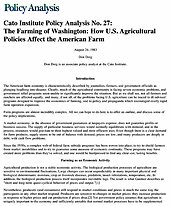Introduction
The American farm economy is characteristically described by journalists, farmers, and government officials as plunging headlong into disaster. Clearly, much of the agricultural community is facing severe economic problems, and government relief programs seem unable to significantly improve the situation. But as we shall see, not all farmers and ranchers are affected equally, and many, if not all, of the problems facing U.S. agriculture can be traced to ill-advised programs designed to improve the economics of farming, and to policy and propaganda which encouraged overly rapid farm operation expansion.
Farm programs are almost incredibly complex. All we can hope to do here is to offer an outline, and discuss some of the policy implications.
A market economy, in the absence of government guarantees at taxpayers expense, does not guarantee profits or business success. The supply of particular business services would normally equilibriate with demand, and in the process, resources would gravitate to their highest valued and most efficient uses. Even though there is a clear demand for farm products, supply seems to be out of balance with demand, prices are low, and many producers are deeply in debt, with cash flow problems.
Since the 1930s, a complex web of federal farm subsidy programs has been woven into place, to try to shield farmers from market instabilities and to try to guarantee some measure of economic continuity. These programs may have created more problems than they’ve solved, and one would be hardpressed to find any clear-cut, lasting benefits.
About the Author

This work is licensed under a Creative Commons Attribution-NonCommercial-ShareAlike 4.0 International License.
